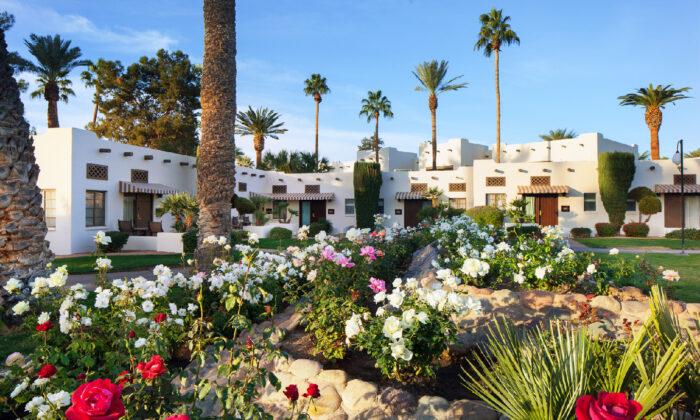Spring has sprung, and summer will soon arrive. If you’re a flower gardener—and the National Gardening Association estimates that members of more than a third of American households are—you already may have begun to till soil and plant seeds. If you enjoy gardens more by watching than working, however, now is the time to plan a trip to take in some of Mother Nature’s bountiful beauty.
Gardens come in a variety of types, sizes, and offerings. Some are urban pockets of color and scent, others world-famous destinations that people travel far to see.
They also can turn pages of history, amaze with their beauty, and at times amuse.
Wherever you live—or go—there are no doubt parks and plots that can satisfy a longing for the splendor that flowers, shrubs, and trees provide.
Many city dwellers live close to outstanding public gardens. Residents of Los Angeles have easy access to what is said to offer more types of plants than any other botanical garden in the world. They’re located in 16 themed areas at the Huntington Library, Art Museum, and Botanical Gardens. The gardens include sections devoted to native plants of California, Australia, China, and Japan; desert, jungle, and subtropical flora; and herb and rose gardens.

Vibrant colors team with chapters from the past in Charleston’s gardens. That South Carolina city is home to three spectacular settings that were born in pre-Revolutionary times. Magnolia Gardens were established in 1671 and once listed as among the three most outstanding attractions in the United States, along with Niagara Falls and the Grand Canyon. Moss-draped live oaks spread their branches over masses of color that line inky lakes.
Water is also a major feature of Cypress Gardens, where island-studded lagoons reflect a blaze of color. What today is a swamp garden in the mid-18th century served as a freshwater reservoir for a nearby rice plantation.
Middleton Place also was an important plantation when creation of its gardens got underway in 1741. They were laid out in the classic style then in vogue in Europe, which accounts for the descending terraced lawns that lead to the oldest camellia plants in the Western world and more than 100,000 azaleas.
Portland, Oregon, touts itself as the City of Roses, and the International Rose Test Garden alone could be reason enough for that moniker. It was founded as a safe haven for hybrid flowers grown in Europe during World War I. The grounds are divided into several areas where more than 10,000 roses thrive.
A very different atmosphere greets visitors to two Asian-inspired settings in Portland. The Japanese Garden is considered to be the most authentic one of its kind outside of Japan. Among five distinct areas are a Strolling Pond Garden, Sand and Stone Garden, and Bonsai Terrace. The Lan Su Chinese Garden offers an immersion in an authentically designed Ming Dynasty-style atmosphere. The richly planted landscape encompasses open colonnades, graceful bridges, and covered walkways.
Touches of humor add to the appeal of some topiary gardens, where shrubs and trees are trained and trimmed into ornamental shapes. At Ladew Gardens in Maryland, they echo the love of hunting by the property’s original owner. Topiary scenes include horses, riders, and hounds pursuing an unfortunate fox.
More whimsical wildlife inhabits Green Animals Topiary Garden in Portsmouth, Rhode Island. In addition to an elephant, ostrich, and unicorn, there’s a menagerie of teddy bears and more than 75 other fauna figures.
Animals—along with a table, chair, and geometric forms—are features at Longwood Gardens near Philadelphia, but they’re just for starters. Sharing its 1,100 acres are woodland, hillside, and meadow gardens as well as indoor environments that mimic desert regions, South America, and places where orchids thrive.
Some resorts and hotels around the country add magnificent floral attractions to their other amenities. The gardens at Antrim 1844 in Taneytown, Maryland, whose name indicates its founding date, are bedecked by more than 80 varieties of English tea roses, which make it a popular venue for weddings. A secluded Secret Garden features a changing display of annuals.
More than 8,000 rose bushes, citrus trees, and towering palms are among plantings at The Wigwam in Arizona, which has been a world-class resort since 1929. Its 440-plus acres of lush landscapes also include colorful spreads of seasonal flowers and native cacti. The Wigwam’s spa uses rose petals from its garden in some treatments.

Welcome surprises extend beyond what you might expect when visiting a garden. People strolling through the Desert Botanical Garden in Phoenix follow trails that lead to plants that thrive in some of the hottest and driest parts of the world—desert wildflowers and vegetation that has been used by native people for food and medicine.
Therapeutic horticulture benefits also are a focus at the Coastal Maine Botanical Gardens, which sprawl. Here also is a forest that includes nearly a mile of tidal saltwater frontage. It offers a Nurturing Connections program for people facing physical, social, or emotional challenges that is intended to evoke the benefits of close encounters with nature.
Even zoos can serve double duty as places of floral beauty. In addition to its resident animals, the Cincinnati Zoo offers green, conifer, and pollinator species gardens. There also is an area that demonstrates the environmental advantages of having rooftops do double duty as growing mediums.
When You Go
Victor Block is a freelance writer. To read features by other Creators Syndicate writers and cartoonists, visit the Creators Syndicate website at Creators.com. Copyright 2021 Creators.com





